You have a great idea for a product, you just need to design and implement product design. For everything to go smoothly, it is worth getting acquainted with the classic stages of product development. Let’s start from the very beginning. Today we will describe the main stages of product development with helpful tips. Product design trends can serve as inspiration for your own idea. But, before we move on to considering the main stages of work, the main features of a working idea should be identified:
- the product is useful;
- easy to use;
- allows you to solve a number of user problems;
- unique (or as much as possible supplemented with useful functionality);
- has monetization capabilities.
If you doubt that the idea can work, you should not worry everything new is scary. But it is the pioneers and innovators who make the most of the profit.
Table of Contents
Concept stage
There is no alternative text for this image. Expect to create a general proposal for how the product works and render its appearance. It’s a time of experimentation and cheap direction changes. A well-thought-out concept takes production technology into account from the outset. However, it is based on a large number of assumptions that will be tested later. The result of the work will be visualizations in the form of mockups, renders, and graphs. What you need:
- Please contact a technician and dealer.
- Selected initial implementation technology.
- Estimated implementation budget and unit cost.
- A specific customer segment.
A vision of the desired aesthetic and functional effect through photography and inspiration.
The more information you provide to the designer at the initial stage, the easier it will be to adapt to the project’s expectations.
What information is needed for productive collaboration?
Here are some tips:
- Consider whether your or design taste will drive design through future market success.
- Beware of seemingly small but costly aesthetic and functional treatments.
- Set aside time for experimentation and dead ends, there won’t be a better or cheaper moment for that.
- Take care of the quality of the connection. Loss of contact can lead to the implementation of unverified design assumptions in the project.
Above all, remember that you are building a team that achieves one goal.
Functional stage
Product design and development services end at this stage. It must contain all the technologies and manufacturing methods required to implement it. Close collaboration between:
- technologist;
- marketer;
- and a designer.
It is focused on practical aspects. At this stage, the cost of changing the project assumptions will be an order of magnitude higher than at the conceptual stage. This is worth remembering so as not to waste your money.
What do you need?
A complete team consisting of a designer, a technologist and a person responsible for contacting the customer. Accurate and proven product concept that avoids project binding. Well-established methods of team communication, especially if it is a remote project. Pre-selected company implementation team. A precise design process that empowers you to make effective decisions. (Who, how, where, when, why) Secured funding. Your project is about to start eating up your money like a sponge.
Implementation phase
Do you have doubts about the effectiveness of your product? Don’t start the implementation phase. Repeat a functional or even conceptual step. If the scaled product does not meet the needs of your customers, you will suffer huge losses.
Has the design changed due to implementation requirements? Contact the designer for advice. Engineers tend to focus on making a product work, rather than ease of use and aesthetics. In this way, the cost of many months of work can be reduced.
Follow the work closely. You must be sure that no one picks labels that you don’t approve of with your blood.

